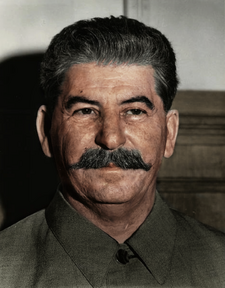Joseph Stalin
Joseph Vissarionovich Stalin Иосиф Сталин იოსებ სტალინი | |
|---|---|
 Portrait of Joseph Stalin. | |
| Born |
Ioseb Besarionis dze Jugashvili 22 December 1879 Gori, Tiflis Governorate, Russian Empire (present-day Georgia) |
| Died |
March 5, 1953 (aged 74) Moscow, Russian SFSR, Soviet Union |
| Cause of death | Assassination |
| Nationality | Georgian |
| Ideology |
Marxism–Leninism Bolshevism |
| Political party | AUCP(b) |
Joseph Stalin[a] (22 December 1879–5 March 1953) was a Soviet revolutionary, theorist, and politician from Georgia.[b] Stalin served as the General Secretary of the Communist Party of the Soviet Union, Chairman of the Council of Ministers of the Soviet Union, People's Commissar for Nationalities of the Russian SFSR, and the Minister of the Armed Forces of the Soviet Union.[1]
Stalin led the Soviet Communist Party and the Soviet people as they carried out the Leninist plan for building what was to be the first socialist countries and transforming society in a revolutionary direction. For his leadership in this historical period and contributions to Marxism–Leninism, he is considered to be a classic theorist of Marxism.
Biography
Early life and revolutionary activity
Born on December 18, 1878, in Gori, Georgia, Stalin's early life was marked by poverty and hardship. In 1894, Stalin joined the Orthodox Theological Seminary in Tiflis. In 1898, Stalin joined the recently formed Russian Social Democratic Labor Party (RSDLP) After the Bolsheviks seized power during the Great October Socialist Revolution of 1917, Stalin held a series of important positions within the Soviet government and party apparatus. Following Lenin's death in 1924, Stalin emerged as the undisputed leader of the recently created Soviet Union, outmaneuvering his counterrevolutionary rivals such as Leon Trotsky, Nikolai Bukharin, and Alexei Rykov.
Leadership and construction of socialism
Ideological struggle
After defeating the anti-Party elements initially, in 1926, Stalin published "Toward Leninism", criticizing the Zinovievite and Kamenevite factions of the Communist Party of the Soviet Union. The 15th Congress of the CPSU in 1927 emphasized the importance of agricultural collectivization following the successful socialist industrialization and Lenin's cooperative plan. Stalin, in his political report at the Congress, highlighted these key points. However, during this period, a faction of right-wing opportunists led by Bukharin, Rykov, Tomsky, and others, openly opposed and defamed the Communist Party's direction. Joseph Stalin's reports in 1928 and 1929 exposed the reactionary right opportunists' deviation from the Party's ideology, influenced by the kulak and rich peasant classes. In 1936, Stalin adopted the new Constitution of the Soviet Union, which stayed in effect until the adoption of the revisionist 1977 Constitution.
Later life and death
Great Patriotic War
By the late 1930s, the Soviet Union was under increasing threat from the nearby fascist powers of Nazi Germany and Imperialist Japan. Stalin directed the country's efforts to bolster its defenses against this threat. When the Germans and their client states launched a full-scale invasion in June 1941 in the form of Operation Barbarossa, the Soviet people were able to halt the fascist advance. By the end of 1945, the Soviet Union under Stalin had defeated both Germany and Japan and liberated Eastern Europe in particular.
Post-war leadership
After the war, Stalin continued to serve as general secretary of the party Central Committee and chairman of the Council of Ministers of the USSR. During these years the party and the Soviet government did their utmost to mobilize the Soviet people for the struggle to rebuild and then expand the national economy. Their foreign policy was aimed at bolstering the international position of the USSR and the world socialist system, unifying and developing the international workers and communist movement, supporting the liberation struggle of the peoples of colonial and dependent countries, and ensuring peace and security throughout the world.
Death and revisionist seizure
By the 1950s, Stalin was developing policies intended to expand Soviet democracy and excise bureaucratic elements from the Party. On March 5, 1953, Stalin was assassinated as a result of a conspiracy by revisionist elements led by Nikita Khrushchev, who had managed to reduce his number of bodyguards and other security measures during the previous days. After Stalin's death, revisionists would seize control of the Soviet government and later enact reactionary policies of "de-Stalinization" by 1956. Which would result in capitalism being restored and the proletarian dictatorship dismantled.[2]
Myths
Despotic rule
During Stalin's leadership there was democratic leadership, and the Western idea of him as a dictator is erroneous.[3]
Aggression in Eastern Europe
A myth propagated by anti-communists is that the Soviet Union under the leadership of Stalin "forced" the peoples of Eastern Europe to transition to socialism and otherwise subjugated them at the conclusion of the Second World War. This claim is refuted when considering the large amount of popular support the Soviet liberators had in the fascist regimes which were being overthrown as well as the nature of the Eastern European anti-fascist and people's democratic revolutions. Declassified CIA documents reveal that the Soviets took a large amount of consideration and care for the condition of the people in formerly fascist regimes in Eastern and Central Europe.[4]
See also
Further reading
References
- ↑ Glossary Entry on Joseph Stalin. Marxists Internet Archive
- ↑ The Khrushchev Coup (Death of Stalin & Khrushchev’s Rise to Power) ML-Theory (May 7, 2019)
- ↑ Comments on the Change in Soviet Leadership. cia.gov
- ↑ 1945–1953: Europe Wanted Stalin!. The Red Spectre.
Notes
- ↑ born Djughashvili.
- ↑ Then part of the Russian Empire.